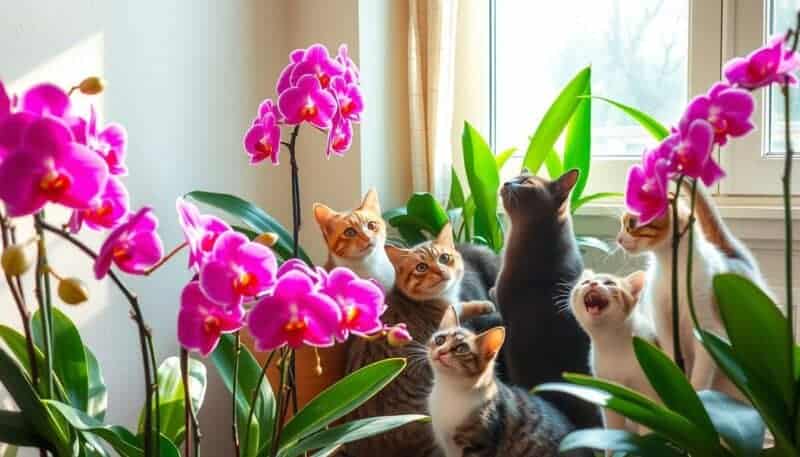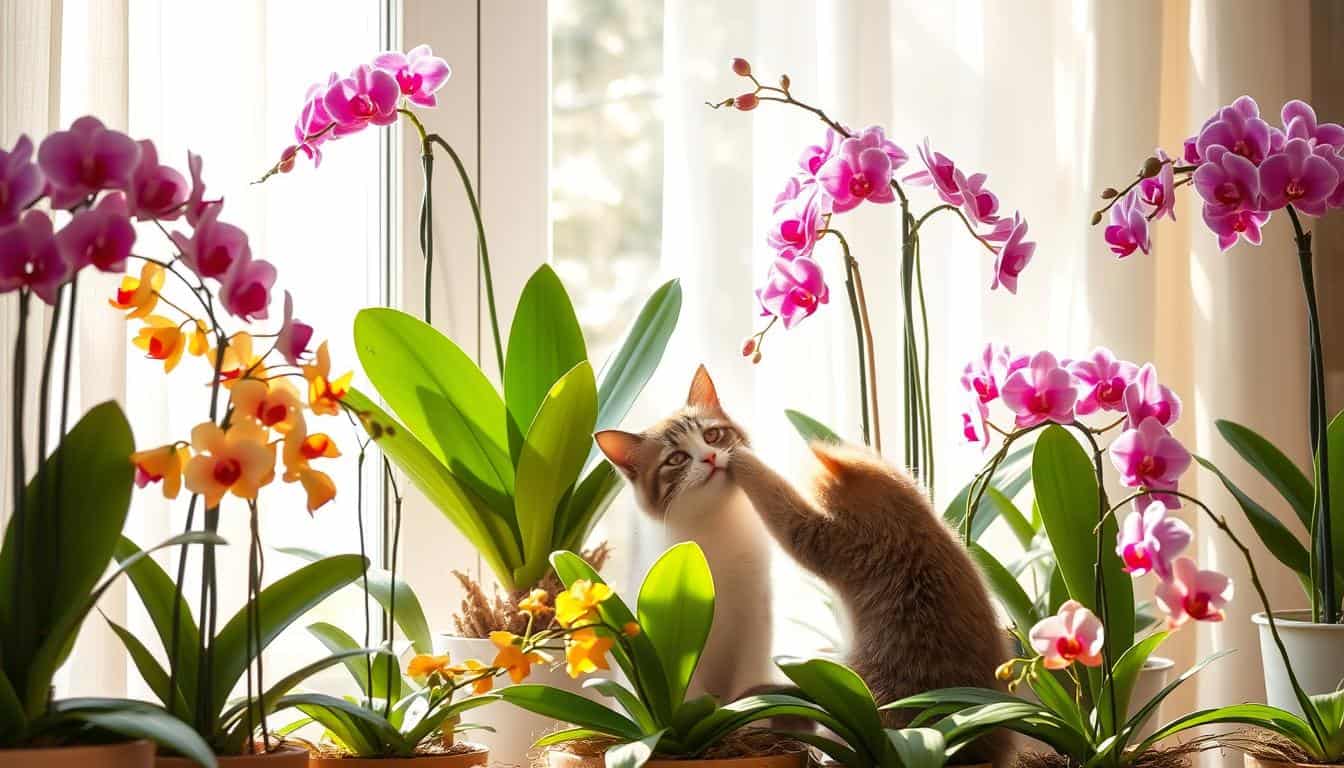Introduction
As a proud cat parent, I know the joys and challenges of sharing your home with cats. They bring endless entertainment and companionship. But, they can also pose challenges when it comes to our beloved houseplants, especially delicate orchids. If you’re an orchid enthusiast and a cat owner, you might wonder: can these two worlds coexist in harmony?
In this comprehensive guide, we’ll explore the intricate relationship between orchid plants and cats. We’ll uncover the dos and don’ts of keeping these two treasures safe and happy under the same roof. Whether you’re a seasoned orchid grower or just starting to build your indoor garden, this article will equip you with the knowledge and strategies to create a pet-friendly haven. This haven will celebrate the beauty of both your furry friends and your botanical beauties.
- Understanding the Relationship Between Orchid Plants and Cats
- Are Orchids Toxic to Your Feline Friends?
- Safe Orchid Varieties for Cat-Friendly Homes
- Signs of Orchid-Related Distress in Cats
- Creating a Pet-Safe Indoor Garden Environment
- Natural Deterrents to Keep Cats Away from Orchids
- Maintaining Healthy Orchids While Protecting Your Cat
- Emergency Response: What to Do If Your Cat Ingests Orchid Parts
- Conclusion
- FAQ:
Understanding the Relationship Between Orchid Plants and Cats
Cats and orchids might seem like an odd pair, but they can impact each other a lot. Knowing how cats act around orchids helps us care for these beautiful flowers better. It’s key for pet owners to grasp this connection.
Common Cat Behaviors Around Orchids
Cats love to explore and play, and orchids are often in their way. They might touch the petals or chew on the leaves, which can hurt the plant. Cats might also knock over orchids, messing with their growth.
Natural Feline Curiosity and Plant Interaction
Cats are naturally curious and might see orchids as something to hunt. They might be attracted to the leaves’ movement or texture. This curiosity can lead to cats digging or climbing on the plants, harming them.
| Common Cat Behaviors Around Orchids | Potential Impacts on Orchids |
|---|---|
| Pawing at petals | Damage to delicate flower structures |
| Chewing on leaves | Disruption of plant growth and health |
| Knocking over or displacing plants | Disruption of optimal growing conditions |
| Digging in soil | Disturbance of root systems and potting media |
| Climbing on plant stems | Physical damage to the plant structure |
Understanding cats and orchids helps us keep a safe and happy home for both. It’s important for pet owners to know this.
Are Orchids Toxic to Your Feline Friends?
Orchids are a popular choice for many pet owners. But, it’s important to know if they are safe for your cat. These flowering houseplants can pose risks to your feline friends.
Not all orchids are toxic to cats. Some are safe for your furry companions. But, some parts of the orchid plant can be dangerous if eaten by your cat.
- The leaves and stems of orchids are mildly toxic to cats. They can cause irritation, drooling, and stomach problems if eaten.
- The flower petals and pollen of some orchids can harm cats. They may lead to vomiting, diarrhea, and allergic reactions.
- The roots and bulbs of orchids are the most toxic. They can cause severe stomach issues, tiredness, and even affect the nervous system in cats.
The toxicity level varies among orchid species. Some, like phalaenopsis (moth orchids), are safer for cats. But, others, like cymbidiums and dendrobiums, may be more dangerous.
It’s key to research the orchid species you want to have at home. Always check with your vet to make sure they are safe for your cats. This way, you can ensure a safe space for both your orchids and cats.
Safe Orchid Varieties for Cat-Friendly Homes
Introducing cat-friendly orchids – a great choice for homes with cats. Many orchids can be harmful to cats, but some are safe. These safe varieties can add beauty to your home without risk.
Popular Non-Toxic Orchid Species
- Phalaenopsis (or Moth Orchids): These elegant orchids are perfect for homes with cats. They have beautiful flowers and are easy to care for.
- Dendrobium: This group includes many safe orchids for cats, like Dendrobium nobile and Dendrobium phalaenopsis.
- Oncidium (or Dancing Ladies): These bright orchids are great for homes with cats. They have lovely, delicate flowers.
Best Placement Options for Orchids
When placing cat-friendly orchids in your home, follow these tips. They help keep your cats safe and your plants healthy:
- Put your orchids on shelves, stands, or hanging baskets. This keeps them out of your cats’ reach.
- Place orchids in rooms or areas your cats can’t easily get to. Try high-up windowsills or special plant zones.
- Use glass or acrylic barriers to protect your orchids. This lets you and your cats enjoy them safely.
Growth Requirements for Safe Species
| Orchid Variety | Light Requirements | Watering Needs | Temperature Range |
|---|---|---|---|
| Phalaenopsis | Bright, indirect light | Moist, but not waterlogged | 65-85°F |
| Dendrobium | Moderate to bright light | Allow soil to partially dry between waterings | 55-85°F |
| Oncidium | Bright, indirect light | Moist, but not soggy | 60-85°F |
Choosing the right cat-friendly orchids and caring for them properly is key. This way, you can enjoy their beauty while keeping your cats safe and happy.
Signs of Orchid-Related Distress in Cats
Felines find orchid plants fascinating, but these flowers can be dangerous. It’s important to watch for signs of distress in cats around orchids. Their contact with these plants can cause serious health problems.
Excessive drooling is a key sign that your cat has met an orchid. Cats drool more when they touch toxic plants as a defense. If your cat is drooling a lot, check your home for orchids.
- Vomiting and diarrhea are common signs of orchid poisoning in cats. These symptoms happen as the cat tries to get rid of the plant’s toxins.
- Cats may also seem tired, lose their appetite, and move clumsily. These signs can mean they’ve reacted to the orchid.
In serious cases, cats might have trouble breathing, have seizures, or even fall into a coma. These severe symptoms need quick vet care to avoid worse outcomes or death.
If you think your cat has touched or eaten an orchid, act fast and call your vet. Quick action can save your cat’s life and health.

Creating a Pet-Safe Indoor Garden Environment
Creating a safe indoor garden for your orchids and pets needs careful planning. Use smart placement and barriers to keep your pets safe while enjoying your orchids.
Strategic Placement Solutions
Keeping your indoor plants safe from pets starts with smart placement. Place orchids on high shelves or inside cabinets. This keeps your plants safe from curious paws and prevents harm to your pets.
Protective Barriers and Deterrents
Use barriers and deterrents to protect your orchids too. Get sturdy stands or cloches to block access. Try double-sided sticky tape or citrus scents to keep cats away.
With smart placement and barriers, your indoor garden can be safe for pets. This way, your orchids can flourish, and your pets can stay safe. A little creativity makes it possible to have a beautiful garden and a safe home for your pets.
Natural Deterrents to Keep Cats Away from Orchids
We know how hard it is to balance taking care of our pets and our botanical curiosities, like orchids. Luckily, there are natural ways to keep cats away from your orchids. These methods are safe and effective.
Using scents is a great way to keep cats away. Cats don’t like strong smells. Try using citrus peels, lemon grass, or lavender around your orchids. These smells can keep curious cats away.
- Citrus scents, like lemon or orange, can keep cats away.
- Lavender and peppermint oils also repel cats because of their strong smells.
- Putting bowls of vinegar near your orchids can also keep cats away. They don’t like the smell.
Another way is to use a tactile barrier. Cats don’t like walking on certain textures. Try using aluminum foil, double-sided sticky tape, or plastic mats around your orchids. The strange feel will keep cats from getting too close.
| Deterrent | Effect on Cats | Benefits for Orchids |
|---|---|---|
| Citrus Scents | Cats dislike the strong, pungent odor | Non-toxic, safe for orchids |
| Lavender and Peppermint Oils | Cats avoid areas with these strong fragrances | Helps deter pests, promotes healthy growth |
| Aluminum Foil | Cats dislike the unfamiliar, slippery texture | Doesn’t harm orchid roots or leaves |
By using these natural deterrents, you can protect your botanical curiosities and keep your cats safe. A little creativity and smart placement can help you enjoy your orchids and keep your cats happy and safe.

Maintaining Healthy Orchids While Protecting Your Cat
Keeping your orchids healthy doesn’t mean fighting with your cat all the time. Use safe ways to feed your plants and keep pests away without harming your cat. This way, your orchids will flourish, and your cat will stay safe and healthy.
Safe Fertilization Methods
Choosing the right fertilizer for your orchids is key. Pick organic, pet-safe options that don’t have harmful chemicals. Here are some good choices:
- Seaweed-based fertilizers
- Bone meal or blood meal
- Fish emulsions
- Compost tea
Always read the instructions and keep the fertilizer away from your cat. This prevents them from accidentally eating it.
Pet-Friendly Pest Control Options
Dealing with pests is part of caring for your orchids. But, many pest control methods can be bad for cats. Here are some organic pest control options that are safer for your pets:
- Bring in beneficial insects like ladybugs or lacewings to fight pests.
- Use a gentle, orchid pet safety-approved insecticidal soap or horticultural oil for specific problems.
- Invite birds to your indoor garden to help control pests naturally.
By focusing on your cat’s safety and using pet-safe methods, you can enjoy healthy orchids and a happy cat.
“The key to a harmonious indoor garden is finding the right balance between plant health and pet safety.”
Emergency Response: What to Do If Your Cat Ingests Orchid Parts
Accidents can happen, and if your cat eats an orchid plant, act fast. Orchids can be toxic to cats. Quick action is key to avoid serious health issues.
First, figure out how much of the orchid your cat ate. This info is important when you talk to a vet. If you can, save any plant parts to show the vet.
- If your cat shows signs of distress like vomiting, diarrhea, or being very tired, call your vet right away. Time is very important here.
- Be ready to tell your vet about the incident. Share the orchid type, how much was eaten, and when it happened.
- Your vet might suggest making your cat vomit or giving other treatments to stop the toxins from being absorbed.
Staying calm and acting fast is crucial for your cat’s safety. By keeping your home pet-proofed against orchid plants and cats, you can lower the risk of such accidents.
“Protecting your feline friends from the potential dangers of orchids is a responsibility all cat owners should take seriously.”
Remember, your vet is your best help in an emergency with orchid plants and cats. With their advice and your quick action, you can keep your pet safe.
Conclusion
Owning orchids and cats can be a joy, if you know the risks and take steps to keep your cat safe. We’ve looked at how orchids and cats interact, including the dangers and how to keep them safe together. This includes the best orchids for homes with cats and how to care for them.
Knowing which orchids are safe and how to care for them can help. You can also use natural ways to keep your cat away from them. This way, you can enjoy your orchids and make sure your cat is happy and healthy.
With the right information and care, you can make a home where both your cat and orchids can do well. By following the tips from this article, you can create a peaceful space for both. This way, your cat and orchids can live together happily.
FAQ:
Are orchid plants toxic to cats?
Orchid plants and cats are typically a safe combination, as orchids are not considered toxic to felines. However, excessive chewing may cause mild stomach discomfort. While orchids pose minimal risk, it’s wise to monitor interactions and keep your cat from nibbling on the plant to ensure both remain healthy and happy.
Are orchids pet friendly?
Orchid plants and cats generally coexist well, as most orchids are considered non-toxic to pets. While orchids are pet-friendly, it’s important to ensure your cat doesn’t chew excessively, as this could cause mild digestive upset. Regular care and placement in secure spots help maintain both plant and feline harmony in your home.
How do I protect my orchid from my cat?
To protect your orchid from your cat, place it on high shelves or use hanging planters. Applying pet-safe deterrent sprays can also discourage chewing. Understanding the dynamic between orchid plants and cats helps create a harmonious environment, ensuring your orchids thrive while keeping your curious feline safe and content.
How do I get my cat to stop eating my orchid?
To stop your cat from eating your orchid, place the plant in a hard-to-reach location or use deterrents like citrus peels around the base. Orchid plants and cats can coexist safely with these measures, ensuring your feline stays away while your orchids remain intact and healthy in your home.
Which flowers are toxic to cats?
Lilies, tulips, and daffodils are among the flowers most toxic to cats, causing symptoms ranging from drooling to kidney failure. Unlike orchid plants and cats, which are typically safe, these flowers should be avoided in households with feline companions. Always research plant safety to protect your pet’s health and well-being.
Are snake plants toxic to cats?
Snake plants are toxic to cats, containing saponins that can cause nausea, vomiting, and diarrhea if ingested. Unlike orchid plants and cats, which are generally safe, snake plants should be kept out of reach. If your cat shows symptoms after chewing a snake plant, contact a veterinarian immediately for advice.
What are the signs that my cat has ingested orchid parts?
Signs your cat might have eaten orchid parts include vomiting, drooling, loss of appetite, and feeling very tired. If you think your cat ate an orchid, call your vet right away for advice.
Share your thoughts in the comments below! If you enjoyed this post, consider subscribing to our newsletter for more pet tips, stories and blogs!

